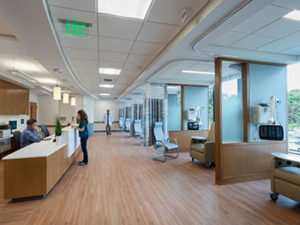YNHH & Greenwich Hospital Open One-Stop-Shop Outpatient Center

STAMFORD, Conn. — A ribbon cutting was held on Sept. 12 to celebrate the official opening of the new Stamford outpatient center from Yale New Haven Health (YNHH) and Greenwich Hospital. Designed by Glastonbury, Conn.-based The S/L/A/M Collaborative (SLAM), the YNHH Greenwich Hospital Multi-Disciplinary Outpatient Center serves as a one-stop shop in the community, consolidating both practice and related provider-based services into one location that is closer to home for local patients.
The SLAM design team had to design within the existing footprint of the building and came up with ways to integrate practice spaces and hospital-based outpatient diagnostic and treatment facilities into a single floor. The 52,000-square-foot outpatient center features physician practice space, laboratory functions, imaging, occupational and physical therapy, and infusion in addition to a Center for Musculoskeletal Care.
“YNHH Greenwich Hospital represents one of SLAM’s longest health care client relationships, and this facility exhibits the latest in clinical planning, design and, most importantly, YNHH Greenwich Hospital’s commitment to delivering care closer to the communities they serve,” said Daniel J. Fenyn, AIA, SLAM Healthcare Market Sector Leader, in a statement. “The facility features treatment spaces for growing programs, including musculoskeletal care, rehabilitation and cancer care, among others, while being flexible to accommodate changing needs.”
A key part of the design is the waiting areas that serve as a central “spine” in the middle of the outpatient center. These elongated waiting areas provide access to self-contained exam clusters that contain physician practices and various diagnostic services, which share registration and waiting functions. This organizational model enhances patient privacy, staff productivity, efficiency and team-based collaboration, according to a statement.
There are alternating, adjoined exam and consult rooms within the exam clusters that provide flexibility based on patient demand for particular specialties. They also offer flexibility for patients and physicians to enter and exit as needed. The design of these rooms helps enhance the patient-physician relationship, with an emphasis on face-to-face communication and enhanced patient engagement, according to a statement.
